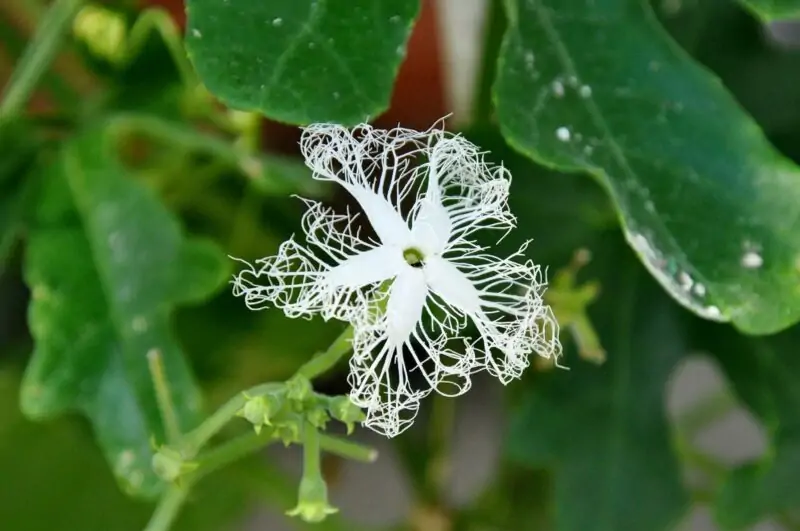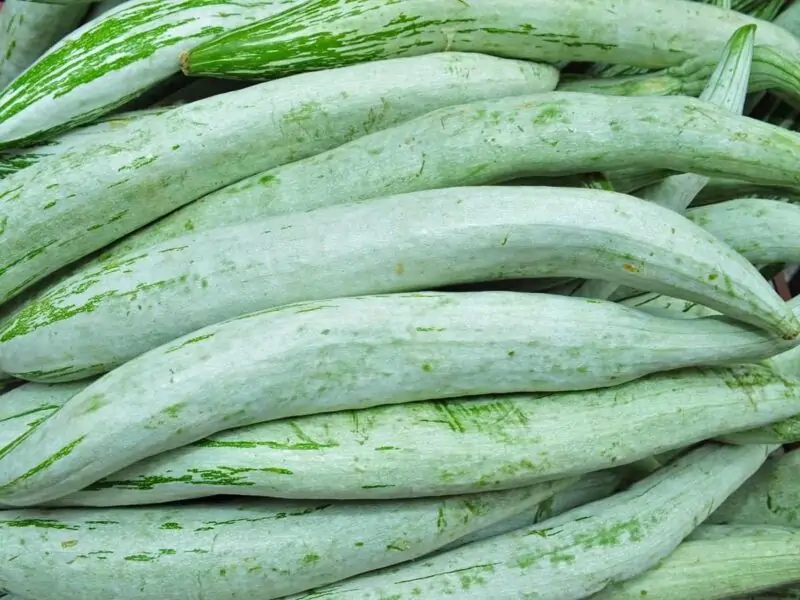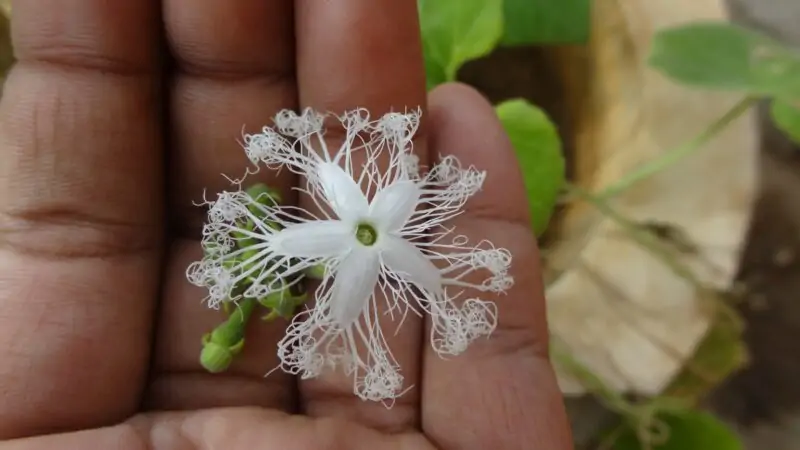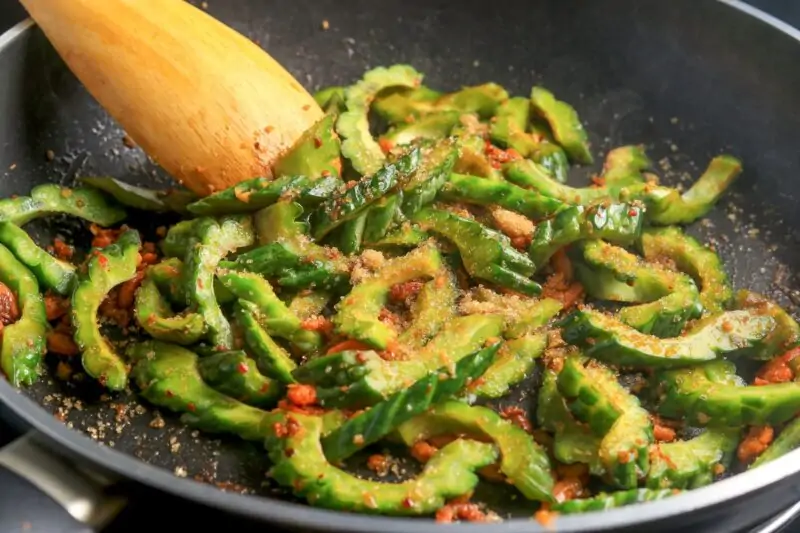Snake Gourd Plant: Everything You Need to Know About Trichosanthes Cucumerina and Its Flowers

Looking for an unusual addition to your veggie patch? Consider the snake gourd! This unique plant produces elongated, bitter-tasting fruit. It adds texture and flavor to your favorite dishes. But what is a snake gourd? Where does it come from? How do you grow it? We’ll answer these questions and more in this article.
Unveiling the Snake Gourd
The snake gourd (Trichosanthes cucumerina) is part of the Cucurbitaceae family. This family also includes melons, squashes, and pumpkins. It also has zucchini, luffas, chayote squash, and bottle gourds. The plant earns its common name from its long shape. When fully grown, they can reach 6 feet!
The Snake Gourd Flower: Its Significance
The snake gourd plant is a vine. It produces both male and female flowers along its stem. The flowers appear before the fruits start forming. After pollination, only the female flower becomes a fruit. The male flower wilts after it provides pollen for fertilization. Want more information about this fascinating plant? Keep reading!
What is a Snake Gourd?
Looking for an exotic, healthy vegetable? Try the snake gourd! Scientifically known as Trichosanthes cucumerina, this unique gourd is native to tropical and subtropical regions. It originates from Southeast Asia but is now a part of kitchens worldwide.
Origin and Distribution of Snake Gourds
Snake gourds are believed to have originated in southern India. They spread throughout Southeastern Asia and then to Africa and Madagascar. Today, you can find them growing wild across Southern Asia. They are also cultivated in many other areas.
Varieties of Snake Gourd and Their Features
There are several varieties of snake gourds. Most have elongated fruit that ranges in color. Some are pale green with white stripes, like zucchini. Others are solid green or even speckled with darker markings. Some fruits can reach 1.5 feet long!
The ‘snake squash’ is a popular variety. It resembles summer squash like zucchini or yellow crookneck squash in taste and texture. Another variety is the ornamental snake gourd. It features lacy fringes on their petals when mature.
Snake Gourd’s Cousins: A Look at Related Gourds
- The Cucurbitaceae family includes a wide range of vegetables. This includes pumpkins, squashes, and melons. It also has loofahs, bitter melon, calabash, and chayote.
- Bitter Melon is a relative of the snake gourd. It’s known for its strong bitter taste. It’s often used in stir-fries, soups, chutneys, or pickles.
- Luffas can be used as cleaning sponges once the outer skin is removed. They can also be eaten when young, like summer squash or cucumber.
- Chayote, or Buddha Palm, is a pear-shaped fruit. It can be cooked or enjoyed raw. Chayote vines produce tendrils, like snake gourds.
- Bottle Gourd, or Calabash, has many uses. It can be made into bowls, containers, or musical instruments. Young bottle gourds are edible. Mature ones are not, but they make great birdhouses!
These vegetables share many features with the Snake Gourd. This includes a climbing vine-like structure, tendrils for support, and separate male and female flowers. They also need warm weather and pollination by bees, moths, or butterflies.

Cultivating and Nurturing the Snake Gourd
If you’re a gardener in search of something unique, consider the snake gourd. This vine-like vegetable is part of the Cucurbitaceae family. This family includes familiar veggies like cucumbers, squash, melons, and bitter gourds.
The Snake Gourd’s Journey: From Seed to Plant
To start growing snake gourds, you need high-quality seeds. You can find these at a local garden center or buy them online. After planting in warm soil (around 25°C), germination usually takes about a week. Make sure they get plenty of sun during this time.
After germination, don’t overwater your seedlings. This can cause root rot. Water sparingly but regularly until they mature into sturdy plants with established roots.
Outdoor Cultivation: Tips for Growing Snake Gourd
Snake gourds are native to tropical and subtropical regions. They love hot weather and enough moisture. This makes them great for growing outdoors! Ideally, grow them on a trellis or support structure due to their sprawling vines. The best time to plant is when temperatures reach 20-25 °C during the day and night.
Choose an area with full sun exposure for planting. Avoid competition with neighboring vegetation. Snake gourds need space to grow big!
Watering needs to be met carefully to avoid waterlogging. The soil should be moist but not saturated. Use organic fertilizers every two weeks. This provides the necessary nutrition for the rapidly developing fruits.
Compact Cultivation: Growing Snake Gourd in Small Spaces
You can grow vine plants like snake gourds indoors too! Even in compact spaces like containers or pots on balconies and patios. They just need support to climb towards the sun.
For indoor growing, use well-draining soil with good organic matter. You can add compost to the soil. Place your container near a natural light source. Provide 6-8 hours of light per day. The best temperature range is between 20-30°C.
Flowers and Fruits: Pollinating Snake Gourd Flowers
Your snake gourd plant needs pollination to produce fruit. Snake gourds have unisexual flowers. They are separate on each plant. This means they need pollinators like insects and bees. They transfer pollen from one flower to another.
If you want to grow ornamental serpent gourds, don’t worry about this. Some cultivars even self-pollinate!

Harvesting the Fruit: When to Pick Snake Gourd
When growing snake gourds, keep an eye on the fruit as it ripens. Timing is crucial for optimal taste and texture!
As the gourd matures, its color changes from greenish-white stripes to yellow-brown. This happens after the skin hardens due to prolonged exposure to sunlight and high temperatures.
To check if it’s harvest time, look for visible cracks and a solid feel. If it’s ripe, it’s ready for picking!
Harvesting too early leads to a sour, bitter squash. Waiting too long results in an overly matured seed-filled pulp. This makes them unsuitable for general cooking. However, they can still be sliced into pickles or used as animal feed.
Overcoming Challenges: Common Pests and Problems in Snake Gourd Cultivation
Snake gourds can fall prey to several pests and diseases. Keep a lookout for any problems that may arise. Aphids, caterpillars, and whiteflies can all be problematic. If you spot these pests, use natural remedies like neem oil. Organic insecticides sprays are also available at most garden centers.
Another common issue is powdery mildew. This typically happens when humidity levels increase.
Uses of Snake Gourd and Its Flowers
The snake gourd is a versatile plant. It has been used in many ways for centuries. Both its edible fruit and stunning flowers offer benefits to those who grow it.
Culinary Adventures: Cooking with Snake Gourd
Snake gourds are commonly used in Indian dishes. Their mild flavor makes them excellent for stir-fries, curries, chutneys, and soups. In Ayurveda, snake gourds are believed to have cooling properties. These can help balance out spicy foods.
The elongated shape and hard skin of the gourd give it a unique texture when cooked. Some people even enjoy eating it raw or pickled! With the right preparation, you can make delicious meals with this tropical squash-like vegetable. You can fry it like zucchini or blend it into soups!

Snake Gourd Care: Ensuring Healthy Growth
Growing healthy snake gourds requires care. This includes the seed germination stage through to harvesting time.
It is a good idea to start growing them indoors. This is before moving them outdoors once the weather allows. This way, they get enough light exposure during early development stages. It also protects them from harsh outdoor elements such as rain or wind.
Regular monitoring of soil moisture levels is important. During hot, dry periods, frequent watering should occur. Snake gourds love water but do not tolerate standing water. So, ensure to plant them in soil that drains well.
Best Practices for Gourd Care
Snake gourds need adequate sunlight exposure for healthy growth. Plant them where they can get 6-8 hours of direct sunlight each day. Provide a trellis or other sturdy structure to support their vines as they grow.
Providing enough nutrition is another key aspect of successful cultivation. Use fertilizers rich in nitrogen, phosphorus, and potassium nutrients during early stages. Then, switch to more balanced NPK ratios while monitoring soil fertility conditions.
Finally, it’s essential to watch your plants for common pests. These pests can cause damage and wilting, weakening the overall health of the plant.
Dealing with Potential Diseases
Like any crop, snake gourds can suffer from various diseases. These include powdery mildew or downy mildew. These diseases are caused by fungi attacking the leaves, stems, flowers, and fruits.
The best way to deal with potential fungal problems is prevention. This involves several steps, including keeping the foliage dry during moist weather. You can also spray organic fungicides onto affected areas when necessary.
If caught early enough, these methods often stop outbreaks. So, always keep an eye out for signs of abnormal leaf discoloration or changes in color or texture. These could indicate pest infestations that could lead to issues compromising the entire harvest.
Frequently Asked Questions about Snake Gourd and its Flowers:
No, only the fruit of the snake gourd is edible.
Yes, you can. The container should be large enough for the roots. Also, provide support for the vines to climb.
Snake gourds are ready for harvest when they mature. Their skin turns yellow or white. Tap them with your finger. If they sound hollow, they’re ripe!
Prevention is key! Watch for signs of infestation early on. Take action before it gets too severe. Use organic fungicides and insecticides. These can be mixed with garlic and cayenne pepper soap. Apply it to the affected areas. Follow the guidelines on the manufacturer’s labels carefully.
Proper care is crucial. This goes from seed germination to flowering and fruit set until harvest. Pay attention to potential pest or disease problems. This can help maximize crop yield and quality. It also ensures fresh produce during the growing season. Enjoy delicious meals cooked with this tasty vegetable all year round.
Conclusion
In conclusion, the snake gourd is an amazing plant. It has many benefits and uses. It is a delicious vegetable that can be used in various recipes. These range from stir-fries to chutneys. Its flowers have medicinal properties, making them valuable for traditional medicine.
If you want to grow your own snake gourds at home, remember the importance of proper care. This includes maximizing space by growing them vertically on trellises. Managing common pests and problems is also key. There are several tips and tricks for healthy growth.
More people are learning about this wonderful plant. It can be a food source and a medicinal remedy. We expect its demand will continue to grow around the world.
Consider adding some snake gourd plants to your garden today. There are many varieties available in different shapes, sizes, and colors. You’re sure to find one that’s just right for you!